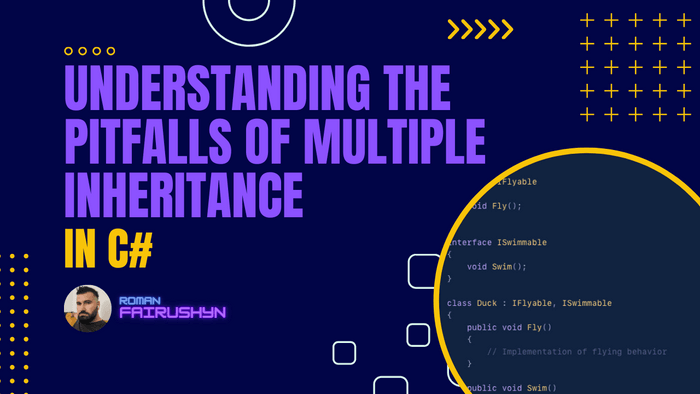Understanding the Pitfalls of Multiple Inheritance in C#
3 min read · — #csharp-interview#senior#pitfalls-of-multiple-inheritance
Introduction: Navigating the Complexities of Inheritance Hierarchies
As experienced software engineers, we often encounter various paradigms and patterns that enhance the flexibility and reusability of our code. Inheritance, a fundamental concept in object-oriented programming, allows us to derive new classes from existing ones, inheriting their properties and behaviors while introducing new features or overriding existing ones. However, the concept of multiple inheritance, where a class can inherit from more than one superclass, introduces a level of complexity and potential issues that are critical to understand.
In C#, multiple inheritance is not supported directly, but its implications and alternative approaches remain a pivotal topic for professionals striving to design robust and maintainable systems. This post delves into the inherent problems of multiple inheritance and explores how C# addresses these challenges, providing real-world scenarios and examples to ground these concepts in practical application.
The Problem with Multiple Inheritance
Multiple inheritance, as found in languages like C++, allows a class to inherit features from more than one base class. This concept, while seemingly offering increased flexibility, comes with significant drawbacks:
1. The Diamond Problem
Consider a scenario where two classes B and C inherit from a class A, and a class D inherits from both B
and C. This forms a diamond-shaped inheritance hierarchy. The problem arises when both B and C have overridden a
method from A, and D needs to decide which version of the method to inherit. This ambiguity can lead to unexpected
behavior and increases the complexity of the code.
2. Increased Complexity and Ambiguity
With multiple inheritance, it becomes increasingly challenging to track the lineage of a class. This complexity can lead to ambiguities and confusion about which superclass's methods and properties are being used, making the code harder to read and maintain.
3. The Issue of Repeated Inheritance
When a class is derived from two classes, which are themselves derived from a common base class, there's a risk of inheriting the same base class more than once. This can lead to redundancy and complications in the class hierarchy.
C# and Interface-Based Solutions
C# addresses the problems of multiple inheritance by disallowing it and instead promoting the use of interfaces. An interface is a contract that defines a set of methods and properties but does not provide implementation. A class can implement multiple interfaces, thereby achieving polymorphism without the pitfalls of multiple inheritance.
Real-World Scenario: Implementing Multiple Interfaces
Imagine a software system for a zoo management application. We have different animal types, and each has distinct behaviors:
IFlyable: Interface for animals that can fly.ISwimmable: Interface for animals that can swim.
interface IFlyable
{
void Fly();
}
interface ISwimmable
{
void Swim();
}
class Duck : IFlyable, ISwimmable
{
public void Fly()
{
// Implementation of flying behavior
}
public void Swim()
{
// Implementation of swimming behavior
}
}In this example, the Duck class implements both IFlyable and ISwimmable interfaces, thereby inheriting behaviors
from two different sources without the problems of multiple inheritance.
Using Abstract Classes and Interfaces Together
C# allows a class to inherit from one base class (abstract or concrete) and multiple interfaces. This approach provides a balance between reusing code (through abstract classes) and ensuring polymorphic behavior (through interfaces).
Consider a scenario in a content management system:
abstract class Content
{
public abstract void Display();
}
interface IStorable
{
void Save();
}
class Article : Content, IStorable
{
public override void Display()
{
// Display the article
}
public void Save()
{
// Save the article to a database
}
}In this case, Article inherits the Display method implementation from Content and the contract to implement Save
from IStorable.
Conclusion: Embracing Interface-Based Design in C#
While C# does not support multiple inheritance, its emphasis on interface-based design promotes a more structured and less error-prone approach to object-oriented programming. Understanding the pitfalls of multiple inheritance and the alternatives provided by C# is essential for designing efficient, maintainable, and scalable software systems. As software engineers, embracing these concepts allows us to create more robust architectures, where the focus is on defining clear contracts and responsibilities, rather than navigating the complexities of convoluted inheritance hierarchies.
